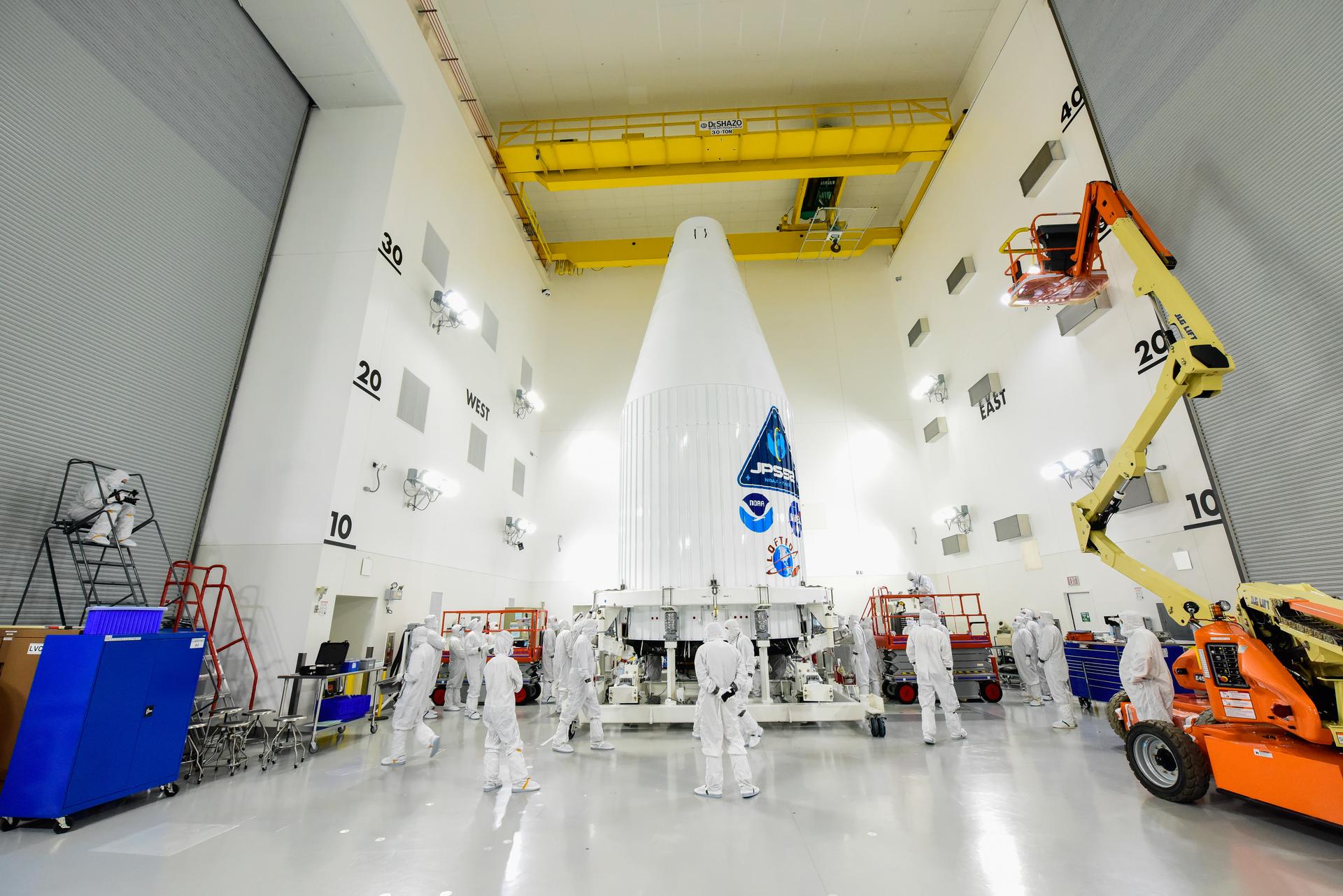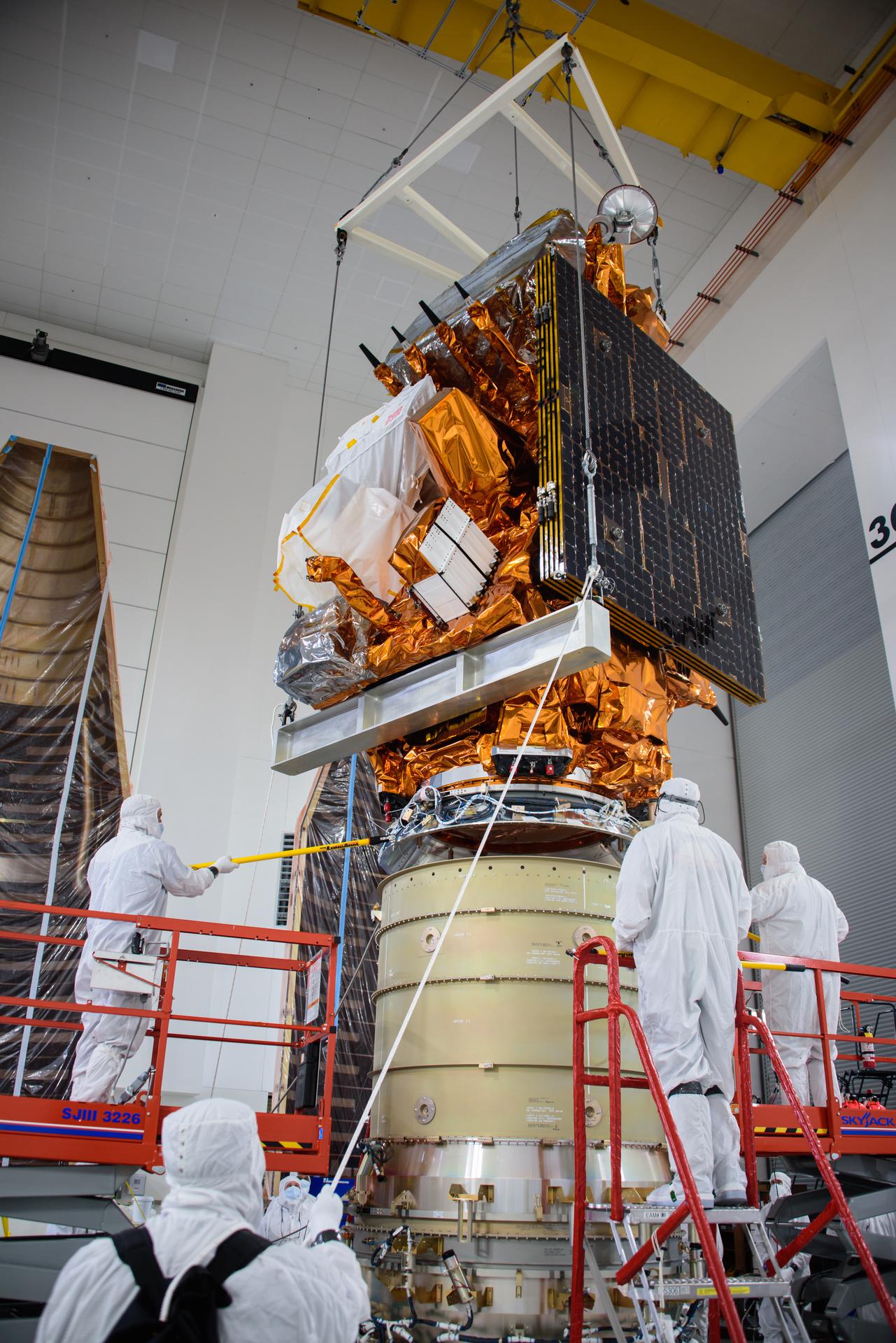
By Danielle Sempsrott
NASA’s Kennedy Space Center
Two very different payloads flying on one rocket are ready for their ride to space. Creating an integrated stack that stands approximately 27 feet tall, the National Oceanic and Atmospheric Administration’s (NOAA) Joint Polar Satellite System-2 (JPSS-2) and NASA’s Low-Earth Orbit Flight Test of an Inflatable Decelerator (LOFTID) spacecraft are safely secured inside the United Launch Alliance (ULA) Atlas V rocket’s payload fairing at Vandenberg Space Force Base in California.
The primary payload, JPSS-2, is the third satellite in the Joint Polar System series – a collaborative program between NOAA and NASA – and will be one of five satellites to capture data and improve weather forecasts, leading scientists to better predict for extreme weather events and climate change.

To get JPSS-2 into orbit requires a powerful rocket. The JPSS-2 mission was awarded to ULA in March 2017, and LOFTID was selected to launch with the satellite as a secondary payload.
“Sometimes we end up with excess vehicle performance launching missions, and instead of letting that performance go to waste, we’re going to use it for LOFTID,” Mission Integration Engineer Eric Harloff said.
LOFTID is a technology demonstration of an inflatable heat shield for atmospheric re-entry that could be used to land heavy payloads – like those required for crewed missions – on the surface of Mars. LOFTID will launch into space with JPSS-2 but will return to Earth in a re-entry test just over two hours after launch.
LOFTID Chief Engineer John DiNonno said that launching with JPSS-2 as a rideshare is a mutually beneficial way for NASA and ULA – a partner on the LOFTID mission – to perform an orbital flight test at lower cost, without requiring a dedicated launch for LOFTID.
A Challenging Flight Design
Determining how to integrate two spacecraft so they both fit inside the payload fairing without damaging each other, all while ensuring they can perform their individual missions following liftoff, wasn’t easy.
“Overall, it’s a complicated payload stack, but it’s actually very exciting,” Harloff said. “There are many different partners supporting this mission and it took a considerable amount of teamwork and collaboration to meet key mission milestones.”
One of the primary challenges faced by the JPSS-2 and LOFTID teams was the flight design. LOFTID is housed inside a payload adapter canister mated with JPSS-2. Then, the entire stack is enclosed inside the rocket’s payload fairing, which had to be modified to a taller height to accommodate the stacked spacecraft. Shortly after liftoff, the first stage of the Atlas V rocket will separate from the launch vehicle, followed by payload fairing jettison. Next, JPSS-2 will separate from the Centaur second stage to begin its mission.
JPSS-2 will be put into orbit 512 miles above the Earth’s surface, allowing it to make detailed observations of our land, atmosphere, and oceans. The satellite will orbit from the North to the South Pole 14 times a day to provide full global coverage. JPSS-2 will provide earlier and more targeted warnings of devastating weather events such as floods, hurricanes, snow and ice storms, and wildfires, helping with evacuations and emergency preparations.
With JPSS-2 safely in a polar orbit, the Centaur then performs a maneuver to put it in a lower orbit. It will use its engine to slow down, moving it and LOFTID back toward Earth. The payload canister covering LOFTID will release and the heat shield will then inflate, with LOFTID on its re-entry trajectory. LOFTID will test the performance of the largest inflatable heat shield to date.
“For LOFTID to be a rideshare, it must be as passive as possible during launch to not interfere with JPSS-2, so LOFTID will be powered off during launch,” said DiNonno. “After JPSS-2 is on its way to polar orbit, the Centaur will de-orbit and LOFTID will power on to begin its demonstration.”
LOFTID is managed and funded by NASA’s Technology Demonstration Missions program within the agency’s Space Technology Mission Directorate and led by NASA’s Langley Research Center in Virginia. The mission is dedicated to the memory of Bernard Kutter, a manager of advanced programs at ULA who championed lower-cost access to space and technologies.
“The entire ULA team did an outstanding job to ensure everyone’s requirements could be met acceptably,” Harloff said.
With JPSS-2 and LOFTID secured inside the payload fairing, teams will now transport the entire fairing to Space Launch Complex-3, where it will be lifted by crane and placed atop the Atlas V in preparation for liftoff. Launch is targeted for Nov. 1, 2022. NASA’s Launch Services Program, based at the agency’s Kennedy Space Center in Florida, is responsible for managing the launch service.



























